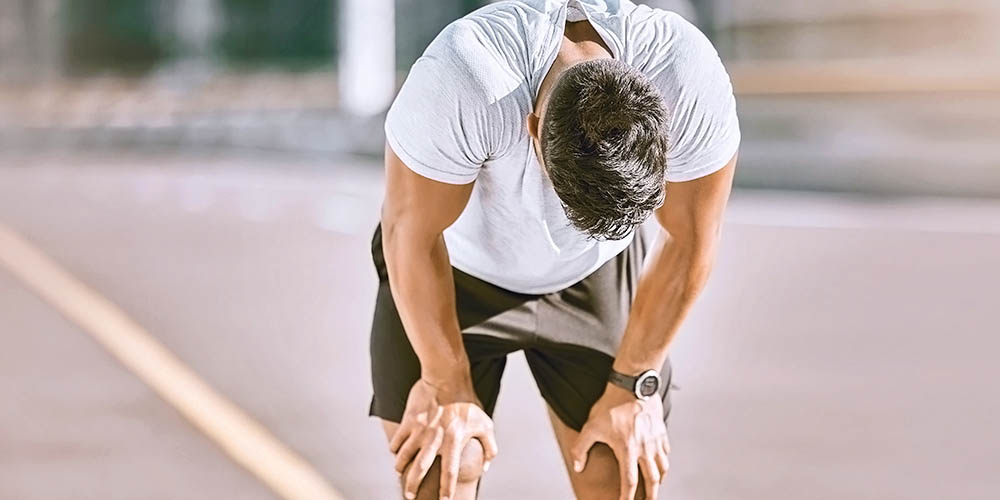
Reading Time: 5 minutes
This case is important to highlight for the following reasons:
- It happened to me – I had an episode of hypoglycemia while exercising with my hybrid closed-loop insulin pump system.
- Everyone with type 1 diabetes struggles with managing blood sugars during exercise (and if you don’t struggle with it, please share your secrets!)
- These new hybrid closed-loop insulin pump systems are a godsend, but they can wreak havoc in certain situations!
I’ve lived with type 1 diabetes for over 50 years, and most of the time I’m pretty good at managing it. But it’s incredibly frustrating when you’re trying to exercise and your blood sugar starts dipping down too low or shooting up too high during a workout.
Even with the advancements of hybrid closed-loop (HCL) technology, sometimes you’ve got to trick the system or come up with workarounds to avoid hypoglycemia and keep you in your target range.
Meet The Patient: ME!
Steve is a handsome 69-year-old endocrinologist with type 1 diabetes who uses a hybrid closed-loop system called Loop. I also wear a Dexcom G7 CGM and an Eversense 365 CGM. I wear them both because I love to geek out on technology!
Even though I use Loop, the issue I discuss in this case study could occur with any of the hybrid closed-loop insulin pumps on the market.
What Are Hybrid-Closed Loop Insulin Pump Systems?
Hybrid closed-loop insulin pump systems are insulin pumps that take blood sugar readings from a continuous glucose monitor (CGM) and utilize a special algorithm that tells the pump how much insulin to deliver to the user.
The five HCL systems on the market (Loop is not included because it’s not FDA-approved) are:
All of these systems use automatic insulin delivery (AID) based on glucose values they receive from the CGMs they communicate with.
Automatic really does mean automatic, so if your glucose level goes above the target you’ve set, the pump secretes insulin to bring you back down.
Most of the time these HCL systems have a target between 100 and 130 mg/dL, depending on the person.
How to Use Exercise Mode with a Hybrid Closed-Loop Insulin Pump System

All of the HCL systems have exercise settings that are designed to help the user avoid hypoglycemia while running, cycling, playing tennis, or even mowing the lawn (please come over to my house if you love to mow the lawn).
Typically the main exercise setting raises your target value so the system reduces insulin delivery until your glucose value reaches the new higher target (150 or 160 mg/dL, for example). This can take a while, which is why it’s recommended that you set your exercise target at least one to two hours before you start working out.
This all sounds good so far, right?
The Problem: Hypoglycemia During Exercise with Type 1 Diabetes
Here is the frequent pitfall of trying to avoid exercise-induced hypoglycemia with an HCL system with automatic insulin delivery:
When you’re in exercise mode (remember this should be set one to two hours before you start working out), your glucose level may go up for several reasons:
- Adrenaline: Sometimes in the morning when I’m running around getting ready for a bike ride, the stress hormones (epinephrine, glucagon, and cortisol) will raise my blood sugar even if I don’t eat.
- Foot to Floor Phenomenon: Some people experience a rise in blood sugar as soon as they get up, even if they haven’t had anything to eat yet.
- Caffeine: Caffeine can cause a rise in blood glucose, so if you like to get pumped up before you exercise, just know the caffeine may raise your blood sugar.
- Hot Showers: For me, taking a hot shower or bath can artificially raise my blood sugar. (Other people can experience lower blood sugar levels with a hot shower or bath).
- Food: If you had something to eat before you exercise, your glucose values may go well above your higher exercise target even if you gave yourself a reduced bolus because you were going to exercise.
In these situations, your hybrid closed-loop insulin pump system has no clue that you’re going on a super long bike ride, so it secretes insulin into your system – sometimes a LOT of insulin depending on your trend arrows.
The excess insulin combined with exercise will cause hypoglycemia – usually to the point where you have to ingest a ton of carbs. Then you end up on the blood sugar roller coaster which totally wrecks your workout.
This has happened to me several times. The most recent situation happened a few weeks ago when I was on a 50-mile bike ride. My HCL gave me too much insulin and I went low, so I ate a bunch of carbs and then of course went really high. I started my bike ride at 240 mg/dL, went down to 50 mg/dL, and then leveled out after eating a small amount of carbs. Not fun.
This screenshot from my phone shows my glucose level at 185 with two arrows up before exercise. Also, note that I suspended insulin delivery for an hour.

This second screen shot below shows that I nailed it on the last part of my ride!
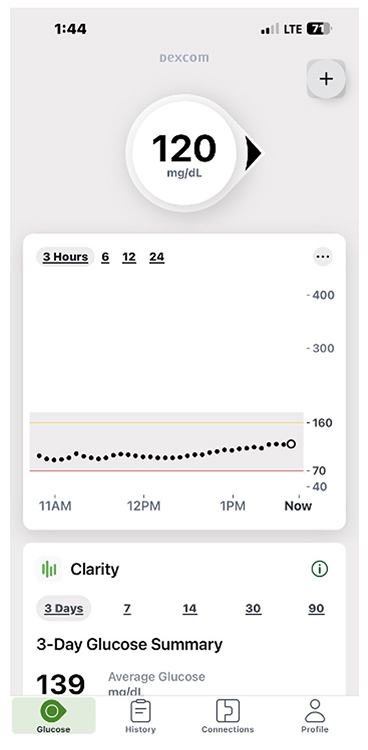
The Solution: Exercise Tips for People with Type 1 Diabetes on Hybrid Closed-Loop Insulin Pump Systems
So, how do you combat this frustrating experience that can totally wreck your workout? I have a few tricks regarding exercise and type 1 diabetes.
Tip # 1: Utilize the Exercise Setting on Your HCL System
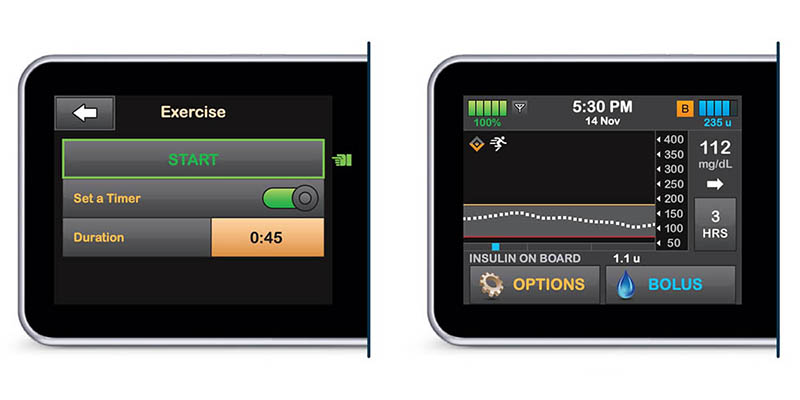
I set my exercise blood sugar target between 150 to 160 mg/dL one to two hours before I start exercising. Sometimes I raise it as high as 180-190 mg/dL so I don’t get extra insulin. My normal target is 105 mg/dL. My insulin sensitivity factor is 1:100 when I’m exercising like that, and it’s only 1:40 normally.
I keep a super close eye on my glucose values, and if I catch a rising glucose with upward trend arrows, I suspend insulin delivery and wait until the glucose levels out. Sometimes I’ll even raise my target to above what the glucose value is for an hour to fake out the system so it does NOT give me any extra insulin.
Also, try to turn exercise mode off 20 to 30 minutes before you stop exercising to prevent the post-exercise rise.
Tip # 2: Try Inhaled Insulin Afrezza

If I eat something with carbs before I ride, inhaled insulin Afrezza is a good option for a bolus because it gets into your system fast and then gets out of your system fast, which is especially important so there’s a lower chance for exercise-induced hypoglycemia.
Tip # 3: Plan Your Meals and Snacks

If you can, try to eat meals at least three hours before you start a lengthy workout so the insulin and glucose are more stable.
Before a workout I usually eat foods low in carbs so I don’t have to bolus, but even low-carb foods like beef jerky, nuts, and cheese can still raise blood sugar.
Tip # 4: Avoid the Post-Workout Rebound High

There are a few things you can do to avoid a post-workout rebound high:
- A cool down after exercise like running or biking is super important. If you’re on a stationary bike, slow your pace and lower your incline for the last 10 minutes, or if you’re out for a run, walk the last mile home. Don’t go full throttle for your workout and then just stop.
- Take a couple of units of insulin 10-20 minutes before you finish your workout to help get some insulin on board.
- If you do have a rebound high (sometimes we call them “hollow highs” because it’s the adrenaline kicking in) and you need to correct, try giving yourself half as much insulin as you normally would.
The Takeaway
Exercising with type 1 diabetes and trying to stay in range is one of the most frustrating things about living with diabetes. Hybrid closed-loop insulin pump systems are amazing, but this is one area when dumb pumps (pumps that don’t communicate with continuous glucose monitors) in the old days made exercising easier because they did not give insulin automatically.
The bottom line is that managing exercise and type 1 depends on a lot of factors that can vary from person to person. Like so many things with diabetes, it will be trial and error to see what works for you and the type of exercise you like to do.
To prove my point about how hard it is to stay in range while working out, Jeremy and I did an exercise challenge where we competed to see who had the better blood sugar management strategy. We both went up and down – you be the judge of who won!
Check out our other diabetes challenges and our resource library for more tips on living well with diabetes.
Additional Resources:
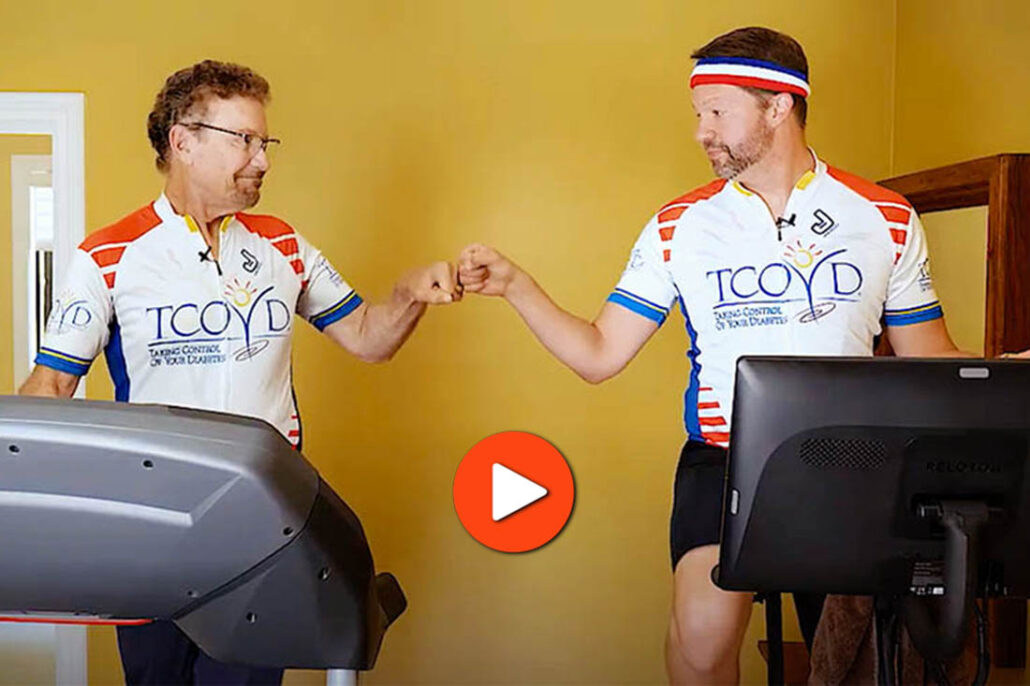

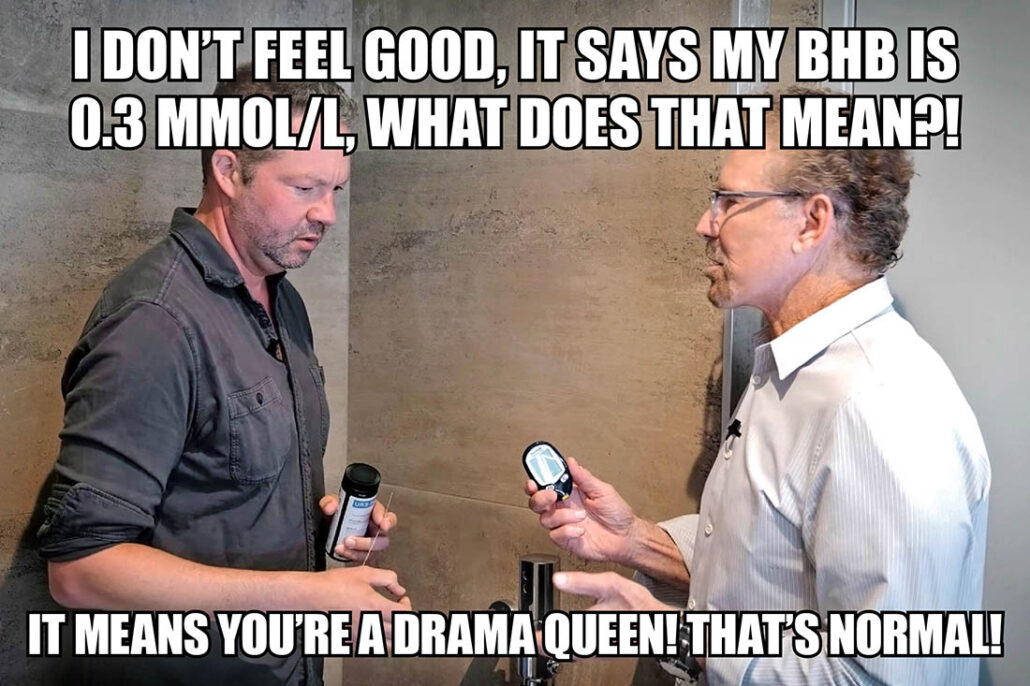
OMG IVE HAD TYPE ONE FOR 69 years!!! I do 3-4 h of exercise a day run swim bike hike rower eliptical weights. I’m 74 and have been doing this my entire life… I have a Medtronic pump and dexcomg6. I don’t use the pump that you have. I’m so brittle!!!! Loved your advice hope to see you at ONE 2025 in San diego
Wow, you are amazing! Hope you can make it to ONE! 🙂
?
Eating steal oatmeals with fruits and greek yogurt for breakfast in morning ok to eat before going to gym and do weights
If it’s working well for you, yes!
I cut bolus by 50% to cover pre-exercise meal taken within 30 min of long bike ride (60-90min). I take carb while cycling and try to cover at 50% because of increased insulin sensitivity. 20-30 min before end of ride I bolus to cover some of carbs that I lowered the bolus for, and for any basal that was suspended during the ride. This prevents me from a rapid and steep post exercise spike.
Good plan – thank you for sharing!
I do nothing for morning ballet classes, but need to either have no IOB or uncovered carbs on board for afternoon or evening classes. I never remember to use the “Ease Off” feature of my hybrid closed loop (I use Ypsopump and CamAPS). I also rarely remember to actually book in properly for my classes, so 🤷🏻♀️.
I have Skittles with my water and pointe shoes in class, and will Skittle-up when I hit 5mmol/L with a diagonal down arrow. Or higher if I know I have miscalculated. I have never had to stop class to treat though. Just Skittles and keep dancing!
“Skittle-up”! That’s great! 🙂
Hi! Thanks for your interesting article and your advice.
T1D (42 yrs). I am trying to explain to another T1 the importance of not “feeding” exercise/insulin to avoid weight gain (and to promote weight loss). I have tried to explain, however, my information is not being perceived well. I am trying to balance scientific info with simple info that a lay-person will get.
My endo explained it very well to me several years ago when I was trying to lose weight. It worked. So you have some advice on how I can better communicate?
Thank you!
Hi Davida,
We aren’t totally sure what you are asking…can you clarify your question? Thank you!
Exercise seems way less complicated with mdi – I just carb up a little so I’m around 160-180 at start of workout and usually end up in the 80-100 range after abt an hour of swimming/biking. Did a couple day long rides back to back last year. Halved my long acting for day 1 and ate unlimited carbs every 1.5 hrs or so(the rest stops were v well stocked).on day 2, I skipped basal completely.
Thank you for sharing that, because after several issues of dealing with my HCL and exercise, I agree with you!
Excellent tips! I use the Medtronic MiniMed 780G and have finally figured out how to exercise without going low, but it’s definitely been a learning curve! Temp target mode helps, but the real important key is having little or no insulin on board, if possible, which means exercising first thing in the morning before eating, or 3 hours after eating, or eating very low carb foods beforehand, without bolusing. Sometimes doing a mealtime bolus for half the amount works as well, but it depends on how strenuous the exercise it. Having to deal with going low really takes the fun out of exercise… Watching my CGM the whole time is not fun either!
Whether it’s a quick walk or a long bike ride, it’s sure possible to achieve balance when using an insulin pump, but it does take planning and practice.
You are SO RIGHT! 🙂
I am a little confused. In your article, you stated that if you see your levels going up with upward trend arrows, you suspend insulin delivery till you level out. How does suspending insulin bring your level down? My dilemma is definitely the post exercise spike. I am pretty good at taking an hour walk and not dropping low (I started the activity mode and lowed my basal to 80% about 1.5 hours before the walk and I started the walk about 130 and stayed around 110 -120 during the walk), I stopped both my activity mode and lowered basal rate about 1/2 hour before the end of the walk. In fact, I put my temp rate at 110% 15 minutes before the end of the walk and still shot up to 210 about 45 minutes after the walk. Of course it is taking forever to get this sugar down now. I really think getting insulins that work quickly is the only way I’ll be able to keep sugars down after exercise. :/
The reason I suspended my insulin was because I had a false high from hot water, and my HCL was giving me insulin thinking that number was real. When I got out of the shower and cooled down, my CGM went back to accurate readings.
Regarding spikes after exercise, you can try a couple of things:
1. You can try going back to your regular settings sooner than half a hour before stopping exercise
2. You can give yourself a small bolus
3. You can also try Afrezza for the post-exercise spike
Going to 210 is really not bad – you’re doing a great job!
There is another great option that is being used in DIY loop using the pre exercise basal reduction. With an activity lasting 45 min, you reduce the basal (to 50-75%) for 45 min pre activity. The move the basal back to 100% for the activity. It’s like magic, and the real plus is that the BG rise post activity is not there. No extra post activity bolus needed. It really works great. Now within Control-IQ+ you don’t have to turn off CIQ to get temp basal and you can set the time to have the temp basal stop automatically when you start the activity. And no food pre or during activity.
Thanks so much Stephen..I will try it!
I have a Tandem T Slim pump and use Dexcom G7. I used to drop into the 50’s 5miles into a bike ride. I have managed it pretty well now by
1) having ZERO IOB for a walk or ride
2) starting activity mode and an exercise profile with very minimal basal and corrections 30-60 minutes pre workout
3) having a very small snack with protein and fat (a few slices of apple or banana with PB before a longer workout.
4) if I can’t plan for zero IOB or we ride our bikes somewhere for a meal, I give a reduced insulin dose with Afrezza as the doctor mentioned. It is AMAZING for this. A big 👍🏻for Afrezza for this purpose. I love it!
Yesterday, I did a long ride with a friend using those measures. I did not have a hypo (Yay!) and only a minimal rise afterwards. I was very happy.
Then, shortly after I went to bed, I dropped in the low 60’s and had to drink juice twice followed by chocolate milk to get it back up and to stay up. 😩. All that calorie burning exercise wasted!
Does anyone have suggestions to combat a delayed low post a more intense workout?
Thanks for your comment – it just goes to show how tough it is to exercise when you have type 1 diabetes. i think I would focus more on what you’re eating after exercising – like having a combination of protein, fat and carbs so the protein and fat take longer to be absorbed. And you can also leave your pump in exercise mode longer.
Fantastic article. I have had T1 for 18 years now and exercise related lows have been a (very frustrating) part of life since diagnosis. Technology has been a huge help all the way. I love my HCL system which I’ve had for just 2 years and it has taken me 2 years of troubleshooting, trial and error and reading books and articles to figure out tips that work for my current exercise patterns and my current HCL. Every part of this article, all the lived experiences, resonate with my experiences over time. For me little to no insulin on board by whatever means makes for the easiest route to hypo avoidance. But acknowledging that that can be a big ask if exercise is spontaneous or my pump manages to sneak in some insulin despite all my best laid plans. Just the last few weeks I’ve skipped breakfast to exercise fasting- amazing! And now I’m really focused on 3 hours ‘fasting’ before evening exercise (I cycle to and from work). Hunger is the main downside but the post exercise food tastes all the better! Would love to try affreza to allow for less ‘fasting’. Thanks again for this brilliant article.
Wow, thank you for sharing!! 🙂